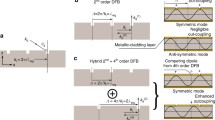Abstract
Loading a grid with diodes offers the possibility of two-dimensional control of millimeter waves that is analogous to holography and nonlinear optics. These grids are attractive because they are suitable for monolithic integration with gallium-arsenide Schottky diodes and for high-power operation. Here we present grid designs for electronic beam-steering and harmonic generation. The beam-steering grid is a programmable reflector, where the diode bias controls the phase shift of the reflection. The variation of the phase across the grating sets the direction of the reflected beam. The reflection loss in computer simulations is 3dB at 90GHz. The harmonic-generating grid acts as a nonlinear reactive surface, where the nonlinear capacitance of the diodes produces the harmonic frequencies. Quasioptical filters select the desired harmonic. Computer simulations predict that a 65GHz-to-130GHz doubler would have an output power of 0.56W/cm2 and a conversion efficiency of 35%.
Similar content being viewed by others
References
G. Latmiral and A. Sposito, “Radar Corner Reflector For Linear or Circular Polarization,”J. of Res. of NBS, 66D, pp. 23–29, 1962.
J. A. Arnaud and A. Pelow, “Resonant-Grid Quasi-Optical Diplexers,”Bell Sys. Tech. J., 54, pp. 263–283, 1975.
R. E. Collin,Field Theory of Guided Waves, McGraw-Hill, New York, 1960, ch. 12.
R. Watanabe, “A Novel Polarization Independent Beam Splitter,”IEEE Trans. Microwave Theory Tech., MTT-28, pp. 685–689, 1980.
N. Nakajima and R. Watanabe, “A Quasioptical Circuit Technology for Shortmillimeter-Wavelength Multiplexers,”IEEE Trans. Microwave Theory Tech., MTT-28, pp. 897–905, 1981.
R. Ulrich, T. J. Bridges, and M. A. Pollack, “Variable Metal Mesh Coupler for Far Infrared Lasers,”Appl. Opt., 11, pp. 2511–2516, 1970.
D. B. Rutledge and S. E. Schwarz, “Planar Multimode Detector Arrays for Infrared and Millimeter-wave Applications,”IEEE J. Quantum Electronics, QE-17, pp. 407–414, 1981.
P. P. Tong, D. P. Neikirk, D. Psaltis, K. Wagner, and P. E. Young, “Tracking Antenna Arrays for Near-Millimeter Waves,”IEEE Trans. on Antennas and Propagat., AP-31, pp. 512–515, 1983.
J. W. Mink, “Quasi-optical power combining of solid-state millimeter-wave sources,” submitted for publication.
G. G. MacFarlane, “Quasi-Stationary Field Theory and Its Application to Diaphragms and Junctions in Transmission Lines and Wave Guides,”Proc. Inst. Elect. Eng., 93, Part 3A, pp. 1523–1527, 1946.
J. R. Wait, “Impedance of a Wire Grid Parallel to a Dielectric Interface,”IRE Trans. on Microwave Theory and Tech., MTT-5, pp. 99–102, 1957.
R. E. Horn, H. Jacobs, K. L. Klohn, and E. Freibergs, “Single-Frequency Electronic-Modulated Analog Line Scanning Using a Dielectric Antenna,”IEEE Trans. on Microwave Theory and Tech., vol. MTT-30, pp. 816–820, 1982.
R. H. Park, “Radant Lens: Alternative to Expensive Phased Arrays,”Microwave Journal, pp. 101–105, 1980.
R. V. Garver, “360o Varactor Linear Phase Modulator,”IEEE Trans. on Microwave and Tech., vol. MTT-17, pp. 137–147, 1969.
K. Lundien, R. J. Mattauch, J. Archer, and R. Malik, “Hyperabrupt Junction Varactor Diodes for Millimeter-Wavelength Harmonic Generators,”IEEE Trans. Microwave Theory Tech., MTT-31, pp. 235–238, 1983.
J. A. Berning and P. H. Berning, “Thin Film Calculations using the IBM 650 Electronic Calculator,”J. of the Opt. Soc. of America, 50, pp. 813–815, 1960.
M. N. Afsar and K. J. Button, “Precise Millimeter-Wave Measurements of Complex Refractive Index, Complex Dielectric Permittivity and Loss Tangent of GaAs, Si, SiO2, Al2O3, BeO, Macor, and Glass,”IEEE Trans. on Microwave Theory Tech., MTT-31, pp. 217–223, 1983.
J. W. Archer and M. T. Faber, “High-Output, Single- and Dual-Diode, Millimeter-Wave Frequency Doublers,”IEEE Tran. on microwave Theory and Tech., MTT-5, pp. 533–538, 1985.
H. Siegel, A. R. Kerr, and W. Hwang, “Topics in the Optimization of Millimeter-Wave Mixers,”NASA Technical Paper 2287, Mar. 1984.
J. W. Archer, “A Novel Quasi-Optical Frequency Multiplier Design for Millimetere and Submillimeter Wavelengths,”IEEE Trans. Microwave Theory and Tech., MTT-32 pp. 421–427, 1984.
Author information
Authors and Affiliations
Rights and permissions
About this article
Cite this article
Lam, W.W., Jou, C.F., Luhmann, N.C. et al. Diode grids for electronic beam steering and frequency multiplication. Int J Infrared Milli Waves 7, 27–41 (1986). https://doi.org/10.1007/BF01011060
Received:
Issue Date:
DOI: https://doi.org/10.1007/BF01011060




